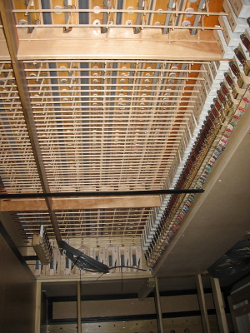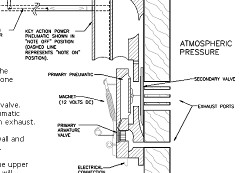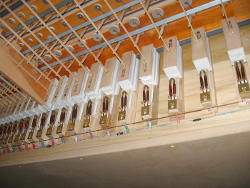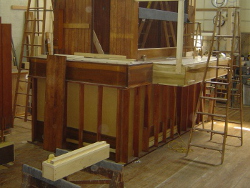
The Universal Airchest is the fundamental feature of the Austin Organ, providing that which no other system can give: absolute and uniform pressure to each and every pipe under all conditions of use.
In any standard pipe organ windchest, the stop controls are normally at one end of the chest where they control each rank of pipes, from bass to treble of a particular tone color, making it ready to speak or be silent (thus forming a matrix). In most windchests, this is channeled through masses of swelling and shrinking lumber. It was this fact and the frustrating inaccessibility for servicing that led John T. Austin to develop the Austin Universal Windchest.
The Austin windchest action is unique in the industry. Essentially mechanical, the chest action is lightweight, strong, extremely durable and very accessible. While it has been well proven in over 100 years of use, the company, nevertheless, carries on a continuing program of research and development. Modern technology has made possible many improvements through Austin’s continuing research program.
The entire chest mechanism is near the chest top (see diagram to the left for more) and the chests themselves are completely open to the bottom. The entire mechanism in the chest is thus visible and accessible from the air chamber below or through large access panels on the underside.
In some cases, the Austin windchests are placed in a room full of air called an airbox, one wall of which is simply made movable. Supplied with springs and connected to the intake valve, it serves as both pressure regulator and reservoir. Use of an airbox also permits easy servicing with the wind on. With less height available, the chest is placed on a low rim, which has easy crawl-in access. Adjustments can normally be made from inside with the wind on and the chest operating. Use of an airbox or rim also permits the easiest possible winding of any offset pipes, with their actions attached directly to the inside of the airbox or rim.
While the pipe bars form the top of the chest, the spaces between the pipe bars are sealed with airtight strips of flexible material, permitting the lumber to expand or contract with seasonal changes without affecting air tightness. The entire Austin structure is engineered to permit these changes without stress. Thus, humidifiers or dehumidifiers are never needed in an Austin organ. This question has plagued many other action designs.
Such a system is obviously very flexible. In the layout of the instrument, first consideration is given to the best possible tonal egress, with the function of each division very much in mind. The adaptability of the system is a tremendous help in this regard, and the inherent accessibility of this type of action will often permit us to install more organ in a given space (when desirable) than can be achieved with other forms of action. Windchests are made in five different standard lengths, 12’-0”, 9’-5”, 8-6”, 7’-9’, and 6-10”, allowing further flexibility in layout. Chests may be chromatic, M style or A style, as the situation warrants. Up to ten stops are placed on one chest. With more than ten stops, two chests are used for each division. Different types of tremolos are used, depending upon the situation.
If, with the changing of fashions and ideals in tonal designs, it is ever desired to make changes, the individual bars can be removed and replaced with bars of different borings. This has often been done with older Austin’s of the ‘teens and ‘twenties and can be a very economical way of salvaging most of the existing structure.
A fine action system, use of modern technology, craftsmanship and the best placement of the instrument are an important prelude to the organ’s function as a fine musical instrument. Add to that the important skills of the voicer working within the framework of intelligent tonal design to give the instrument its ultimate personality.




